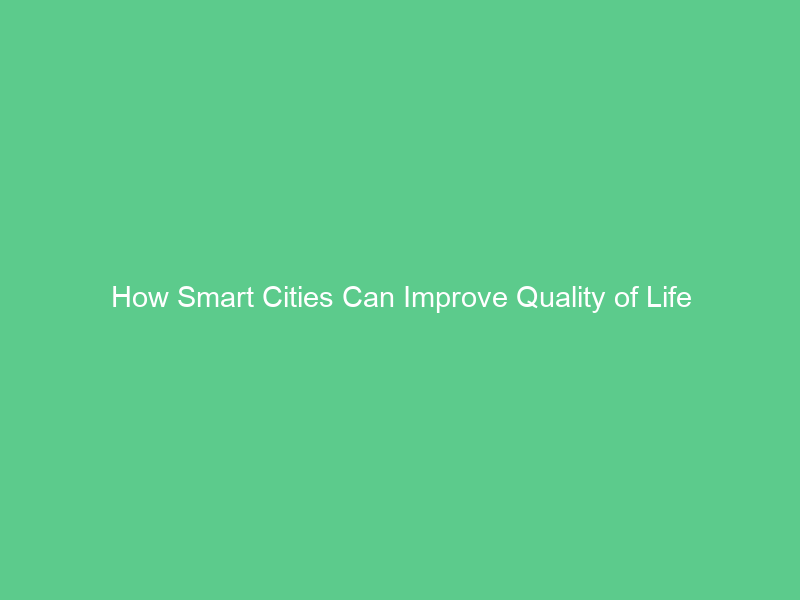City leaders are quickly realizing the potential of smart technology to put transportation, traffic alerts, health services, and community news directly in citizens’ hands. Not only can this innovative approach save costs while simultaneously meeting growing population demands more efficiently.
Community members should have input when purchasing technologies that may encroach upon privacy or civil liberties, as well as being able to assess any smart city projects that may affect them.
Smart Transportation
Smart city systems are intended to monitor and optimize factors that contribute to quality of life such as public transport, waste disposal and energy efficiency. In addition, these technologies also increase accessibility for those with mobility challenges.
However, it’s essential to keep in mind that a smart city requires more than technology for success; it must also feature a cultural fabric that attracts and retains residents. This can only be accomplished when citizens and local governments work together on joint initiatives while sharing data – something which should be made easily available through open data portals and mobile apps.
Smart Grid
Waste management is one of the primary challenges for cities, and requires a system tailored to urban objectives. Smart technologies enable municipalities to implement systems that optimize resource recovery while supporting social cohesion and territorial harmony.
Smart city applications are offering tangible advantages to residents worldwide. McKinsey Global Institute (MGI) conducted studies that examined how several digital apps impact key quality-of-life dimensions like safety and convenience, time and energy use, health issues, environment concerns and jobs.
Applications like these connect citizens directly with their cities, providing instant information regarding transit, traffic congestion, healthcare services, weather alerts and community news to millions of citizens around the globe. LPWAN technologies like LTE Cat M, NB-IoT and LoRa are powering these connections between millions of individuals.
Smart Water
Given increasing water scarcity and climate change, smart cities must take special care in managing their consumption and waste of this resource. Innovative water recycling, desalination and sewage systems can enhance efficiency while decreasing dependence on freshwater sources.
Water utilities can reduce non-revenue water loss (leakage and theft) with sensors and analytics, while residents can keep tabs on their consumption with digital feedback that encourages conservation efforts.
These smart city solutions can often be made accessible to residents through an open data portal or mobile app, increasing engagement and ownership of the technology while helping build trust – which in turn spurs innovation.
Smart Waste
Smart waste management solutions help cities meet their zero-waste goals more easily, using sensors to track waste and notify sanitation crews when bins need emptying; cutting costs while simultaneously decreasing pests and vermin.
Sensors help optimize recycling rates, decrease carbon emissions and ensure compliance with regulations. Real-time bin monitoring ensures bins are emptied quickly to eliminate overflows and enhance service quality.
As more businesses leverage I4.0 tools such as AI, sensors and blockchain for waste management purposes, the market for smart waste management is expected to surpass $16 billion by 2022 (Fig. 3).
Smart Parking
An intelligent parking system reduces time spent searching for parking spots while decreasing emissions caused by vehicles idling idly, while helping cities save money on infrastructure and maintenance costs.
A central hub that links sensors, mobile app, and digital signage works together to optimize parking operations and enhance customer experiences. Furthermore, this technology can also be utilized for dynamic pricing to increase revenues while streamlining payment processing efficiently.
Sharing this data with citizens through an open data portal or smart city apps ensures they can understand it and use it to complete daily tasks more easily, thus creating citizen engagement and making smart cities more transparent.
Smart Buildings
Residents deserve a comfortable, secure, energy-efficient and environmentally-friendly living environment. Optimizing how a building operates helps lower operating costs while simultaneously improving service by harnessing smart technology to respond instantly to changing needs in real time.
Sensor data is analyzed and distributed via strong communication networks to provide insight that can be used to manage traffic, parking and waste management; guarantee water and electricity supplies; enhance public safety; and ultimately enhance livability within cities.
Digital solutions bring efficiency to urban manufacturing and agriculture for job creation, space utilization management and fresher produce for consumers. Download the MGI snapshot to gain an understanding of how smart cities are using digital technologies to make life better for their residents.
Smart Security
Smart cities utilize sensors and connected devices to reduce costs, increase efficiency, and enhance sustainability. Applications analyze constant streams of data to provide insights and recommendations–streamlining waste collection processes, adjusting traffic light cadences accordingly, and directing drivers toward available parking spots are just some of the services a smart city offers its residents.
An important element of smart city technology implementation is a citizen engagement strategy to foster adoption and raise awareness. Residents can use smart city apps such as City Monitor to monitor energy use or their home security status; first responders can communicate directly with citizens using text-to-911 services and direct data links.

